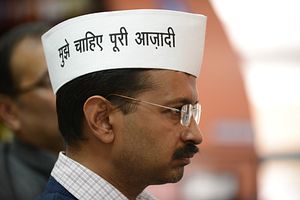After nearly 48 hours under siege, Delhi is gradually returning to normal. The four major metro stations, which remained shut for two days, have been opened and the traffic jams around the city have eased.
The architect of the chaos was none other than the capital’s new Chief Minister (CM) Arvind Kejriwal, a man who captured the imagination of the nation when his nascent political outfit, the Aam Aadmi Party (AAP, or Common Man’s Party) made a startling debut in the elections last month by defeating the two mainstream political parties.
The perennial rebel has been a prominent face of India’s anti-corruption movement since 2011. He received huge support from the people for his anti-corruption activism, support that catapulted him to the helm of Delhi’s government in a little over a year.
But the transformation from rebel to a ruler is proving to be tough for the 45-year old CM.
The sudden sit -in protest by him and his party workers in the heart of the capital this past week indicates as much. Kejriwal went on a flash protest demanding the suspension of policemen who refused to obey the dictates of Law Minister Somnath Bharti.
Last week, the new minister called some local police to his area in the night and asked them to raid a house where some women from Uganda and Nigeria were living. He alleged that the African women, who were living in the lower middle class area of southern Delhi called Khirki Extension, were drug traffickers and prostitutes. Police refused to act in the absence of any warrant and any prior complaint. With camera rolling Bharti railed against police and called names. According to reports, the harried women were attacked inside their house and some reports suggest that they were made to go through cavity searches by the AAP workers.
The whole episode fomented outrage and the AAP government came in for harsh criticism for the highhandedness of its minister. Demands for the minister’s resignation started ringing in the air.
Pushed into a corner, Kejriwal demanded that complete control of police be placed in the hands of the Delhi government. Delhi is a city state that does not enjoy complete control of its law and order machinery like other states.
Later on, the CM shifted the goalposts and demanded the suspension of the policemen who refused to obey the Law Minister. Kejriwal and party workers started an indefinite strike on January 19 near the parliament, creating chaos and undermining security in the sensitive zone of the national capital.
This was the first time in recent memory that an elected Chief Minister and his entire cabinet sat in on a protest. The protest happened very close to the venue where Republic Day parades take place every year on January 26.
On the evening of January 21 the CM suddenly called off the sit-ins after the center agreed to send the policemen on leave. This was not the demand for which Kejriwal had held the whole capital ransom. However, his critics and the media term the CM’s sudden turnabout as a face saver – a climbdown forced on him by backlash from the people of Delhi.
This was the first such public protest by the activist-turned-politician after assuming power in Delhi. Unlike his previous sit-ins, the latest one didn’t the bring Delhi’s middle class, the backbone of Kejriwal’s anti corruption movement, to the street.
The Times of India writes that dwindling support and bad press forced an end to the protests. No more than 400 people came to support him, and the media reports that those who came were brought in from the neighboring state of Haryana. Additionally, the media debated the appropriateness of a CM protesting an issue which merits debate.
Critics say that Kejriwal’s protest was an attempt to divert the nation’s attention from his faltering Law Minister, whose resignation is being sought by political parties and women’s rights organization.
Whatever the reasons for the protest, the rookie politician has lost a substantial chunk of the people’s support in the last 48 hours – support that was hard earned over the last two years. Be it social networking sites, local FM radio stations, or TV studios, voices against the AAP are audible across Delhi.
What also became visible among the highest echelons of the AAP’s leadership during the protests was a particular intolerance towards the media, which has been unkind in its coverage of Kejriwal’s antics. The CM refused to interact with several journalists and TV networks.
Far before the AAP became an institution, it was an idea. The challenge before Kejriwal is to keep this idea alive. This can be done only through good governance, not through political antics.

































